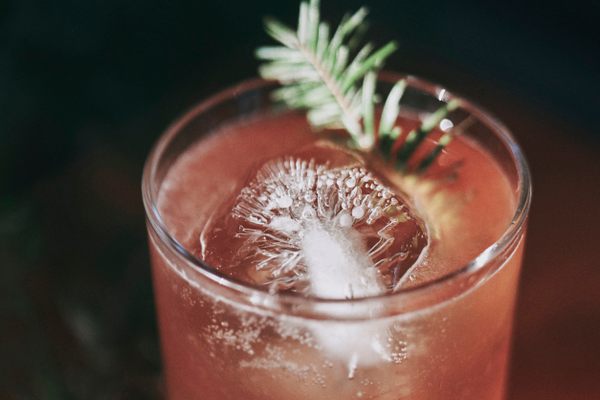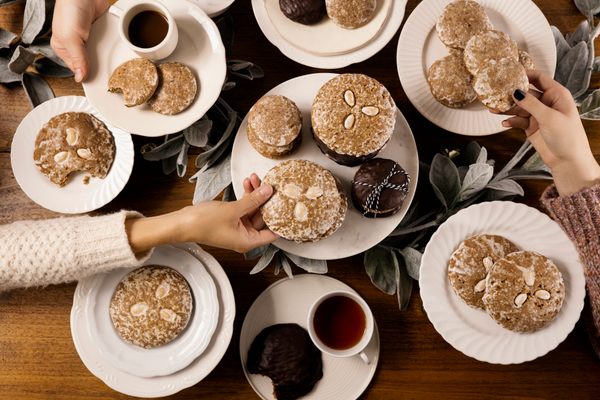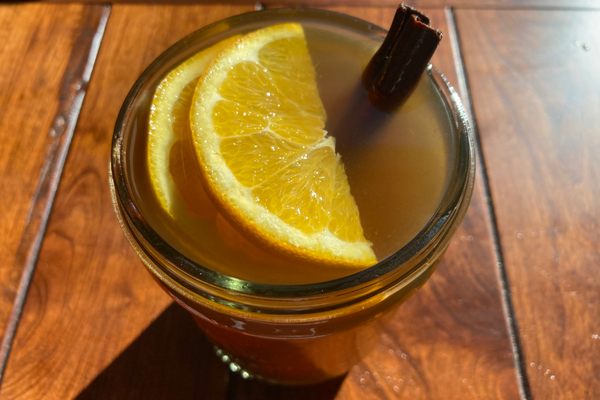How to Turn Your Christmas Tree Into Cocktails
Cooking with evergreens has a long history.
This month, Gastro Obscura is looking at wondrous wintertime cocktails. Yesterday’s recipe was for Germany’s favorite flaming punch: feuerzangenbowle.
After the warm glow of the festive season has left us, after we have overeaten, overspent, and overdone it, a mass culling of trees begins: 40 million of them across the U.S. and UK alone. For those of us who celebrate the Christmas holiday, we enjoy them for only a month or two before dragging them to the curb.
Should we keep these trees hostage in our living rooms? Most Christmas trees are grown for seven to 10 years before they become festive adornments, and the average lifespan of a conifer is 400 years. But we have turned these trees into a single-use product.
In the winter of 2015, I spent a considerable amount of time trying to extend the short shelf life of a Christmas tree. I drove around London’s leafy periphery, pilfering Christmas tree branches. It was odd behavior on my part, but this foraging exercise was rooted in a deep hatred of waste: My goal was to figure out how to eat and drink them.

Soon enough, I was serving dishes such as zesty Christmas tree-cured fish, spruce and ginger ice cream, tart Christmas tree pickles, and sweet apple and fir membrillo. I experimented with cocktails, too: spruce-infused gin, herby pine vodka, and fir cordial. Last year, I published a cookbook, How to Eat Your Christmas Tree, to encourage home cooks to have a good think about wastefulness and sustainability over Christmas time.
I am not the first to try ingesting a Christmas tree—I based my dishes and drinks on recipes from across the globe. For eating, they have been used in pickles and cures and to flavor meats, fish, and cheese through hot and cold smoking methods. When it comes to drinking, pine, fir, and spruce flavors have become a popular bar staple for adding woody flavors to cocktails. Further back, we see them used by Alpine communities in digestifs and liquors such as genepi, zirbenz, and schnapps. Head further north and you will find spruce and pine in Scottish highland ales. A key component of the Greek white wine retsina is the sap of the Aleppo pine. For indigenous people in North America, evergreens have long flavored tea, braises, and stews.
Not all types of Christmas tree taste the same. Pine is warming and subtle, fir can be grassy, and spruce is floral, sharing flavor profiles with vanilla. (In fact, coniferin, which is found in Christmas tree needles, is a key component in artificial vanilla flavoring.) In short, they are delicious.
Most parts of the Christmas tree can be cooked with, from bark to bud, needle to nut. But it’s important to know which trees you can safely incorporate into drinks and dishes. Here are some pointers:
- Spruce, fir, and pine, which are by far the most common types of Christmas tree on sale, are edible. Yews and cedars, which look like Christmas trees but are seldom used, are extremely poisonous. To spot these, note that yews have bright red needles, which edible Christmas trees do not, and that cedar “needles” are much softer than those of a spruce, fir or pine—they almost look like samphire. As always: If in doubt, don’t eat it.
- Although Christmas trees are a crop, they are not necessarily grown for consumption. I have come across trees that have been sprayed with chemicals, or even painted green. Don’t eat these! Instead, find a responsibly, and, ideally, locally grown tree that’s been treated with as few chemicals as possible.
- Christmas tree needles are a bit like fish bones—they’re often sharp. So avoid eating any uncooked, unchopped needles.
If you are going to buy a tree this year, I recommend buying a live one and either keeping it in a pot as a houseplant or, if you have outdoor space, replanting it once Christmas is over. That’s because if we let just one year’s crop of Christmas trees live out their full life-span, they could absorb slightly more carbon dioxide than the global air traffic industry expels in a year. As a bonus, using a potted plant for a Christmas tree, or replanting yours, means it will become a permanent extension of your drinks cabinet, adding festive flavor to future tipples for years to come.

Christmas Tree Cordial
Recipes excerpted with permission from How to Eat Your Christmas Tree by Julia Georgallis (Hardie Grant Books)
Christmas tree cordial, especially if you are using spruce, tastes a bit like grapefruit juice. Rather than turning green, as you might expect, it will turn a color ranging from bright orange to pastel pink. You can use either fir or spruce, or a mixture of both. I don’t recommend making it with pine as the flavor is a bit too weak and gets overpowered by the sugar and lemons. The flavor of this cordial is quite expansive and zingy.
Makes: 2 liters (70 fluid ounces/8 cups) of cordial
Prep Time: 2 hours
Equipment: a 2-liter (70-fluid ounce/8-cup) glass bottle with a lid
Ingredients
juice of 10 lemons and zest of 4
2 liters (70 fluid ounces/8 cups) water
700 grams (1 pound 9 ounces/ 3 cups) caster (superfine) sugar
400 grams (14 ounces) spruce and/or fir needles (you can also use some of the branches to add flavor)
Instructions
- Sterilize the glass bottle.
- Bring the lemon juice and zest, water, sugar and needles to the boil over a medium-high heat. Turn the heat down to low and simmer for 2 hours.
- Take the pan off the heat and strain through a fine sieve (fine mesh strainer) to remove the needles. Do this a few times to ensure that there are no needles left in the mixture.
- Pour the mixture, using a funnel, into the sterilized bottle.
- Leave to cool and refrigerate. This keeps for a couple of weeks in the refrigerator.

Christmas Tree Sour
Makes: Enough for 2 cocktails
Prep time: 15 minutes each
Ingredients
50 milliliter (1 ¾ ounces/3 tablespoons)
Christmas Tree Cordial (see above)
100 ml (3 ½ fluid ounces/scant 1/3 cup) sparkling water
100 ml (3 ½ fluid ounces/scant 1/3 cup) bourbon or a non-alcoholic spirit like Seedlip or Smreka
3 drops of Angostura bitters
a large ice cube
juice of 2 limes
To make the cocktail, combine all the ingredients, including the ice, preferably in a cocktail shaker, and shake rapidly for a minute. If you don’t have a cocktail shaker, use a jar with a lid instead. Pour into a cold glass and serve.
Christmas Tree Mimosa
Ingredients
70 ml (2 1⁄2 fluid ounces/5 tablespoons) Christmas Tree Cordial (see above)
140 ml (5 fluid ounces/scant 2⁄3 cup) prosecco
a large ice cube
a slice of lemon
To make the cocktail, combine all the ingredients, including the ice, preferably in a cocktail shaker, and shake rapidly for a minute. If you don’t have a cocktail shaker, use a jar with a lid instead. Pour into a cold glass and serve.
Gastro Obscura covers the world’s most wondrous food and drink.
Sign up for our regular newsletter.



























Follow us on Twitter to get the latest on the world's hidden wonders.
Like us on Facebook to get the latest on the world's hidden wonders.
Follow us on Twitter Like us on Facebook